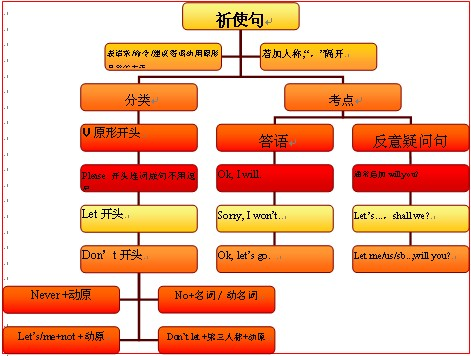本试题 “If you have a job, _____ yourself to it and finally you'll succeed.[ ]A. do devoteB. don't devoteC. devotingD. not devoting” 主要考查您对祈使句
强调句
等考点的理解。关于这些考点您可以点击下面的选项卡查看详细档案。
- 祈使句
- 强调句
祈使句的概念:
表示请求或命令的句子是祈使句。祈使句一般用降调,为使祈使句听起来比较婉转,可用低声调,祈使句句末用句号或感叹号。祈使句有两种类型:含有第二人称和带有第一、三人称主语的祈使句。每种类型又有肯定形式和否定形式。用don't否定时,只能用其缩略形式。
例如:Welcome to Beijing Park.
祈使句的点拨:
一、祈使句的句式特征:
祈使句常常是表达说话人对对方的劝告、叮嘱、请求或命令等。因此,祈使句中一般没有主语,但根据其句意,实际上是省略了主语you。祈使句句末用感叹号或句号,朗读时,常用降调。在表达请求或劝告时,在祈使句前或句末可加上please,以使句子的语气更加缓和或客气。祈使句一般没有时态的变化,也不能与情态动词连用。
例如:Keep off the grass! 勿踩草地!
Put the boxes in the small room. 把那些盒子放到那个小房间里。
二、祈使句的肯定句式:
祈使句的肯定句式一般分为以下三种类型:
1、行为动词原形+其他成分:
例如:Make sentences after the model. 根据例句造句。
2、Be动词+其他成分(形容词、名词或介词短语等):
例如:Be careful when crossing the street. 过马路时要小心。
3、Let+宾语+动词原,形+其他,成分:
例如:Let him go back now. 让他现在回去吧。
三、祈使句的否定句式:
祈使句的否定句式,通常情况下在句首加上Don't或Never,一般分为以下四种类型:
1、在祈使句的肯定句式前加Don't,构成“Don't+行为动词原形+其他成分”。
例如: Don't say that again! 别再那样说了!
2、在Be动词引起的肯定祈使句前加Don't,构成“Don't be+其他成分(形容词、名词或介词短语等)”。
例如:Don't be careless. 不要粗心。
注意:在这种句型中be不能省略;否定副词not不可置于be之后。
3、Let引起的祈使句的否定形式有两种:
(1)Let开头的祈使句,如果后面跟第一、第三人称名词或代词的宾格,可在Let前加Don't,也可在Let后宾格的名词或代词后面加not。
(2)如果以Let's开头的祈使句,必须在Let's后加not。
例如:Don't let me go with her tomorrow.=Let me not go with her tomorrow. 不要让我明天跟她一起去。
Let's not tell her the truth whenever we meet her. 无论什么时候我们碰到她,都不要告诉她真相。
4、在公共场合的提示语中,否定祈使句常用“No+名词/V-ing形式”结构,表示“禁止做某事”。
例如:NOPHOTOS!禁止拍照!
四、祈使句的反意问句:
祈使句的反意疑问句须按其句子结构及讲话人的语气来决定其疑问部分。通常有以下三种形式:
1、祈使句为肯定句式,其反意疑问句表示请求时,通常用will you;表示邀请、劝说时,用won't you。
例如:Be sure to write to us, will you? 你一定要给我们写信,好吗?
Come to have dinner with us this evening, won't you? 今晚来和我们一起吃饭,好吗?
2、祈使句为否定句式,其反意疑问句通常只用will you。
例如:Don't smoke in the meeting room, will you? 不要在会议室抽烟,好吗?
3、Let开头的祈使句构成反意疑问句时,除Let's用shall we外,其他均用will you。
例如:Let the boy go first, will you? 让个那男孩先走,好吗?
Let's take a walk after supper, shall we? 晚饭后我们去散步,好吗?
五、祈使句的回答:
祈使句的动作通常是表示将来发生的动作,所以回答祈使句时,一般用will或won't。在回答具有否定意义的祈使句时,要注意两点:
一是“形式一致”,即Yes与will保持一致;No与won't保持一致。二是“意思相反”,即Yes是“不”的意思;No是“是”的意思。在回答时,要注意分析上下文语境中所提供的条件。
例如:—Don't go out, please. It's raining heavily outside. 请不要出去。外面雨下得很大。
—Yes, I will. I have to meet my brother at the airport. 不行,我得去机场接我弟弟。
祈使句知识体系:

祈使句的使用:
1、祈使句与陈述句的并列使用:
祈使句后接陈述句时,须用连接词连接。如果祈使句与陈述句表示的是一种顺承关系时,要用并列连词and来连接;
如果祈使句与陈述句存在一种否定条件关系时,要用并列连词or来连接。
例如:Leave it with me and I will see what I can do. 把它留给我吧,我想想有没有办法。
Hurry up, or we'll be late. 快点,否则我们要迟到了。
2、祈使句与条件状语从句的连用:
祈使句与条件状语从句连用时,条件状语从句可置于祈使句前或后。
例如:Tell him to make a phone call to me if he comes here tomorrow. 如果他明天来这儿的话,叫他给我来个电话。
3、祈使句的强调形式:
祈使句的强调形式通常在肯定祈使句式前加上助动词Do(Do在句中无意义)。
例如:Do shut up! 快住口!
4、特殊形式的祈使句:
在英语中,有些祈使句不是以动词原形来引起一个祈使句,而是以一个名词短语来充当,且后接一个带有并列连接词的分句。
实际上,这个充当祈使句的名词短语相当于一个条件状语从句。
例如:More water and the young trees couldn't have died.=If you had given them more water, the young trees couldn't have died. 如果你给那些小树多浇点水,他们就不会死了。
5、运用祈使句的误区:
祈使句往往容易与不定式、分词或条件状语从句相混淆。在平时的练习或测试中,如果稍不留神,就会出错。因此,要认真审题,认真分析句子结构,并根据上下文语境,作出正确判断。
例如:_____your composition carefully, some spelling mistakes can be avoided.
A. Having checked
B. Check
C. If you check
D. To check
析:如果空白处选填B(Check)项,则视为祈使句,但后一分句前没有并列连接词and连接;如选A或D项(分词或不定式),句中逻辑主语some spelling mistakes又不能执行这个动作,故均不符合句子结构。因此,只有C项(条件状语从句)符合句子结构及句意。
强调句的概念:
强调句 (The Emphatic Pattern) 是一种修辞,是人们为了表达自己的意愿或情感而使用的一种形式。通过各种方式对句子中的某个部分进行强调,从而起到修辞的作用。英语常用的强调结构有:It is (was)+被强调部分(主语、宾语或状语)+that/who...;what…be…句型;
强调句的使用:
一、强调句句型:
1、用It is/was...that/who...句型表示强调。
(1)陈述句的强调句型:It is/was+被强调部分(通常是主语、宾语或状语)+that/who(当强调主语且主语指人)+其它部分。
e.g. It was yesterday that he met Li Ping.
(2)一般疑问句的强调句型:同上,只是把is/was提到it前面。
e.g. Was it yesterday that he met Li Ping?
(3)特殊疑问句的强调句型:被强调部分(通常是疑问代词或疑问副词)+is/was+it+that/who+其它部分?
e.g. When and where was it that you were born?
注:被强调的部分(通常是句子的主语、状语、宾语或宾语补足语)放在is/was的后面,如被强调的是人,则后面可用who,whom等代替。
如:原句:He met an old friend in the park yesterday.
强调主语:It was he who/that met an old friend in the park yesterday.
强调宾语:It was an old friend that/who he met in the park yesterday.
强调地点状语:It was in the park that he met an old friend yesterday.
强调时间状语:It was yesterday that he met an old friend in the park.
2、用助动词do, does或did来强调谓语动词。
如:Do come early.
He did send you a letter last week.
We're pleased that she does intend to come.
3、用主语从句+be+被强调部分,主语从句常用what引导。
如:What John wants is a ball.
What Mary does every day is(to) give piano lessons.
二、not...until...句型的强调句:
1、句型为:It is/was not until+被强调部分+that+其它部分:
e.g. 普通句:He didn't go to bed until/till his wife came back.
强调句:It was not until his wife came back that he went to bed.
2、注意:此句型只用until,不用till。但如果不是强调句型,till, until可通用;
因为句型中It is/was not...已经是否定句了,that后面的从句要用肯定句,切勿再用否定句了。
三、谓语动词的强调:
1、It is/was...that...结构不能强调谓语,如果需要强调谓语时,用助动词do/does或did。
e.g. Do sit down.务必请坐。
He did write to you last week. 上周他确实给你写了信。
Do be careful when you cross the street. 过马路时,务必(千万)要小心啊!
2、注意:此种强调只用do/does和did,没有别的形式;过去时用did,后面的谓语动词用原形。
使用强调句型有以下几点请注意:
①强调句的谓语is或was永远用单数。
如:It was yesterday that I met your father in the street.
②不管被强调部分是哪种状语,只能用that连接,不得使用where、when等连词。
如:It was in the street that I met your father yesterday.
③被强调部分为人时,可用who(主格或宾格)和whom(宾格)代替that,用that也行。
如:It was your father that/whom/who I met in the street yesterday.
It was I that/who met your father in the street yesterday.
④强调句中也要注意主谓一致、人称一致和否定转移的问题。
如:It is they who are our friends.
It was not until ten o'clock that we got home last night.
⑤注意不要混淆强调句和其他从句。It is/was...that...为强调句标志,去掉后仍可组成一个完整的句子,只是没被强调,而其他从句一般不具备这一特征。
比较:1)It was ten o'clock when we got home last night. 我们昨晚到家时已十点了。
2)It was at ten o'clock that we got home last night. 我们昨晚是在十点到家的。
第一句不是强调句,when不可改为that,因为去掉it was和that后,只能组成“We got home ten o'clock last night.”这样一个不完整的句子;第二句是强调句,that不可改为when。
强调句型用法拓展:
1、句首词用“It”,不能用“This”,“That”等。
2、be动词的形式是is或was,不能用复数形式are或were。若原句的谓语动词用了现在时或将来时,则用is;
若原句的谓语动词用了过去时或过去完成时,则用was。
如:It___the Chinese women that___a great role in the socialist construction.
A. is; plays
B. are; play
C .is; play
D. are; plays
答案:C
3、被强调的部分如果是代词,强调主语用主格,强调宾语用宾格。
如:It is him that/who/whom I met in the street yesterday.
It is I who/that am wrong.
4、连接词一般用that,当强调部分是人时,既可用that也可用who。特别注意当强调部分是时间状语或地点状语时,不能用when或where。
如:It was on Oct1st, 1949 that People's Republic of China was founded.
It was at the gate____he told me the news.
A. that
B. what
C. which
D. when
答案:A
5、主谓一致问题被强调的主语要和that后面的谓语动词在数上保持一致。
如:It is Mary who often _____(help) me with my English. (helps)
It is I that ____(be) against you. (am)
6、not...until结构的强调。
强调“not...until”引导的时间状语时,要用“it is/was not until...that...”结构,that后面的句子要用肯定式,且须用陈述句语序。
如:We did not get off the bus until it stopped. ?
It was not until it stopped that we got off the bus. (注意:强调该结构时not until不能分开)
与“If you have a job, _____ yourself to it and finally you'l...”考查相似的试题有:
- Please do me a favor—________ my friend Mr.Smith to Youth Theater at 7:30 tonight.A.to inviteB.invitingC.inviteD...
- Bob, ___ these brochures among the tourists before you leave, will you?A.having distributedB.to distributeC.distri...
- _____the equipment before you leave, or you will be punished by our chemistry teacher.[ ]A. Remember cleaningB. Remem...
- It was not until the couple arrived at the cinema ____ they found they had left the tickets in the office.[ ]A. whenB...
- — Do you know ________ the 2011 Xiamen International Marathon was held?— On January 2.[ ]A. when it was thatB. when w...
- _______ she was standing and waiting for a bus that she caught sight of the former President Clinton.[ ]A.It was wh...
- Was it from the lake________he often went fishing________he saved the drowning girl?[ ] A. that; thatB. where; whereC...
- — You know Jane?— Yes, it was _____ I surfed the Internet last week.[ ]A. thatB. whenC. whyD. whom
- It was because it rained last night ___ he didn’t come.A.whenB.soC.thatD.so that
- — I'm sorry, I shouldn't have been so rude to you.— You ______ your temper but that's OK.[ ]A. have lostB. had lostC....